How to Catch Striped Bass: Complete Guide to Techniques, Gear, and Locations
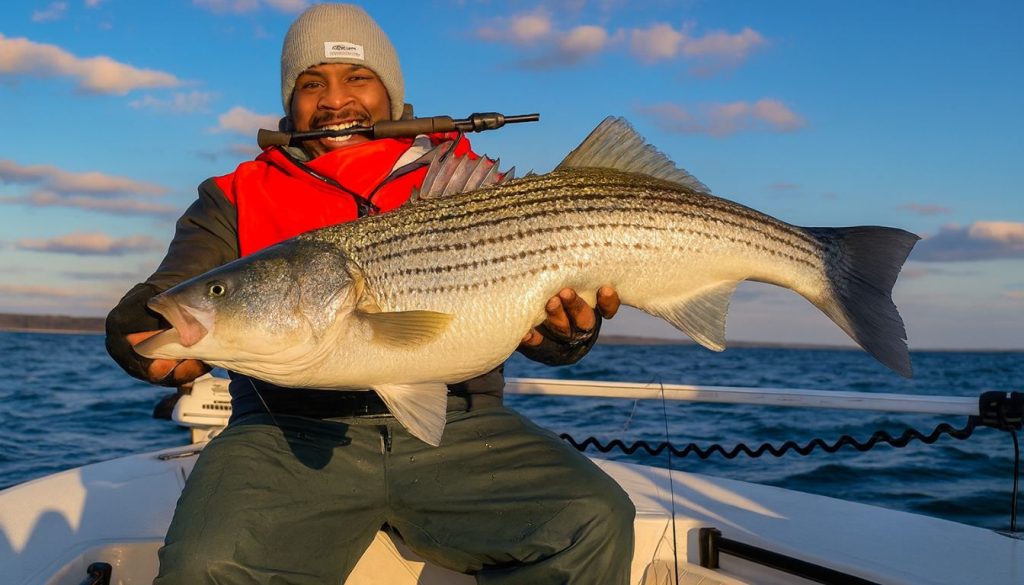
Species Profile
Quick Identification
Striped bass (Morone saxatilis) – also called “striper,” linesider or rockfish – is a silvery, torpedo-shaped anadromous fish with 7–8 continuous dark stripes running from gills to tail. The back is olive-green to black, fading to a white belly.
Adults typically range 20–40″ in length (50–100 cm) and 10–30 lb, though they can grow much larger. The U.S. record is an 84 lb 14 oz striper (54″ long) caught in Long Island Sound, and FWS reports maximum lengths over 6 ft and ~125 lb in historical catches.
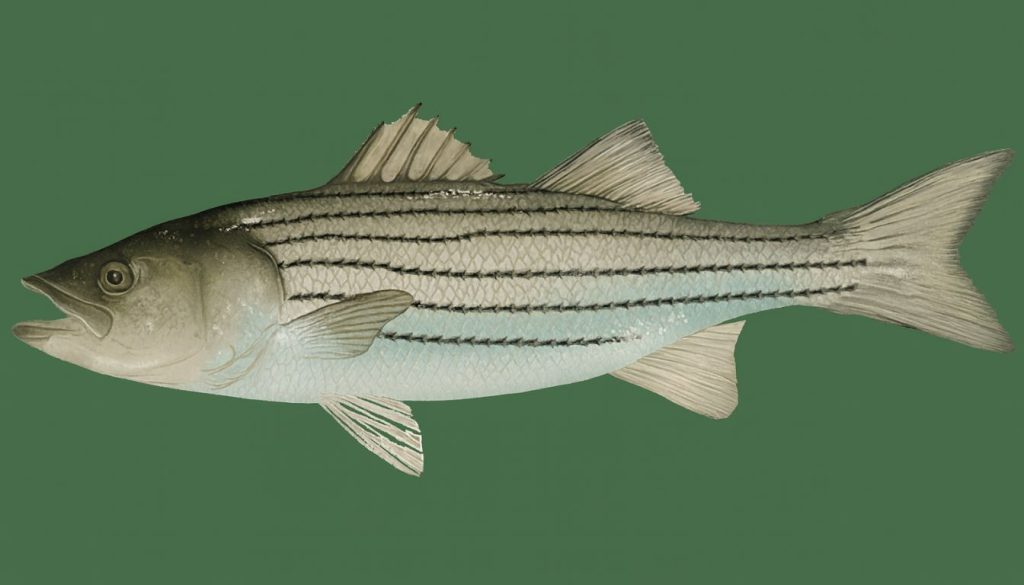
Striped bass inhabit both Atlantic-coast waters and inland reservoirs across the U.S. (with Gulf Coast genetics) and are known for migrating between salt and fresh water.
Why Target This Species
Striped bass are prized by anglers for hard fights and excellent table fare. Even average stripers put up a strong fight, while trophy-class bass (20–60+ lb) give well-seasoned anglers a real challenge on rod and reel.
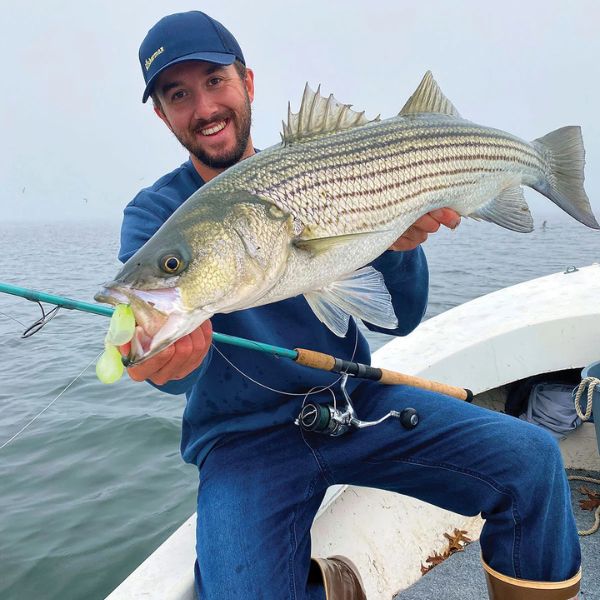
They are rated moderately difficult – requiring good gear and technique – but accessible to dedicated anglers. A premier gamefish, stripers are popular in tournaments and charters; they’re also valued for eating. The flesh is firm, flaky and mildly sweet – more flavorful than cod, yet milder than oily fish like mackerel or bluefish – making them a top table choice when harvested responsibly. Watermen and chefs alike prize wild striper for grilling, baking, chowders, etc. (Note: Atlantic stocks are under strict management, so catch-and-release is common and often required, especially for large fish.)
Best Time of Year: Striped bass are most productive during their migration seasons. In general, spring and fall runs concentrate fish: as water temperatures rise in spring (50–60°F), stripers migrate upriver to spawn; in fall, cooling water brings hungry bass into inshore waters or at the mouths of bays and rivers.
Summer fishing can also be great, especially at night or in deep cool holes when surface water warms (see Calendar below).
Behavior and Feeding
Hunting Pattern
Active predators: Stripers are pursuit hunters that ambush schooling baitfish around structure and current breaks. They lurk in ambush behind drop-offs, points, wrecks, jetties or channel edges, darting onto baitfish as current pushes the forage past. Strong currents and moving water trigger strike responses – stripers often station at eddies, bridge pilings, rip-rap or any “sweet spot” where bait gets swept by tidal flows.
Peak activity: Feeding is heaviest during low-light and moving-tide windows. Dawn and dusk are prime times – stripers commonly hit at first/last light or even at night, especially on warm summer evenings. Tidal shifts also drive bites: many anglers note feeding tends to flare up in the last hour of an incoming or outgoing tide and again at the tide change (slack-to-current). Overcast skies, light rain or moon-driven tides can prolong or intensify these feeding periods.
Schooling vs. Solitary: Juvenile and mid-sized stripers often school tightly around bait, whereas very large “bull” stripers may roam in smaller groups or even alone. When schools of bunker, herring or sand eels are present, many stripers will congregate en masse, causing surface boils and diving birds. Individual trophy bass, however, may hide in structure and take lures one at a time.
Primary Diet
Main prey: Striped bass are opportunistic piscivores. Juveniles consume zooplankton, insect larvae and small crustaceans. Adults feed predominantly on other fish (menhaden/bunker, herring, alewife, anchovies, silversides, shad, small mackerel, etc.) and larger invertebrates (squid and crustaceans like blue crabs). In spring, migrating shad and alewives are prime forage; summer finds them on squid and bunker; fall bait schools draw them in close to shore.
Striped Bass Diet Guide
Understanding What Trophy Stripers Feed On
🎯 Primary Prey Species
Spring
Summer
Fall
Winter
🦀 Secondary Prey
Live & Cut Bait
Artificial Lures
Match the Hatch Strategy
Success with stripers means "matching the hatch" – use the prevalent forage in your area to trigger strikes. In the Chesapeake, focus on live bunker. In surf zones, try clams and sandworms. Watch for bird activity, check local fishing reports, and observe what baitfish are present. When stripers key on invertebrates (especially in tidal creeks or winter), switch to worms or shellfish imitations for consistent results.
Secondary prey: Stripers also scavenge smaller prey such as crabs, worms (sandworms or bloodworms), and even bottom-dwelling prey like sand eels or small baitfish species. In areas with clams or mussel beds, they’ll snap up shellfish fragments that wash by.
Bait/lure choices: Knowing this diet directs your bait selection. Live or cut fish (menhaden, herring, mackerel) and eels mimic the striper’s favorite fish prey, while soft baits and plugs that imitate shad or sand eels match their schooling forage. Bloodworms, sandworms or shellfish imitations can work when stripers key on invertebrates (especially in tidal creeks or winter). In practice, fishing with stripers means “matching the hatch” – use the prevalent forage (e.g. live bunker in Chesapeake, clams and sandworms in surf zones) to trigger strikes.
Where and When to Find Them
Key Habitat
Water types: As anadromous bass, stripers utilize a range of habitats. In spring they move upriver into brackish and freshwater spawning grounds. In summer/fall they roam coastal bays, estuaries and the nearshore ocean. Inland reservoirs in many states also hold landlocked populations. Overall, moving water and structure define striper habitat.
Structures to target: Look for edges and ambush points – drop-offs, submerged points, channel bends, rock ledges, oyster beds and bridge pilings. Anywhere current “smacks” into cover is prime: bridge pilings, rip-rap, jetties, wrecks and rocky shorelines often concentrate baitfish and thus stripers. Salt marsh creeks and river inlets are especially effective in spring/summer when bait flushes out into them.
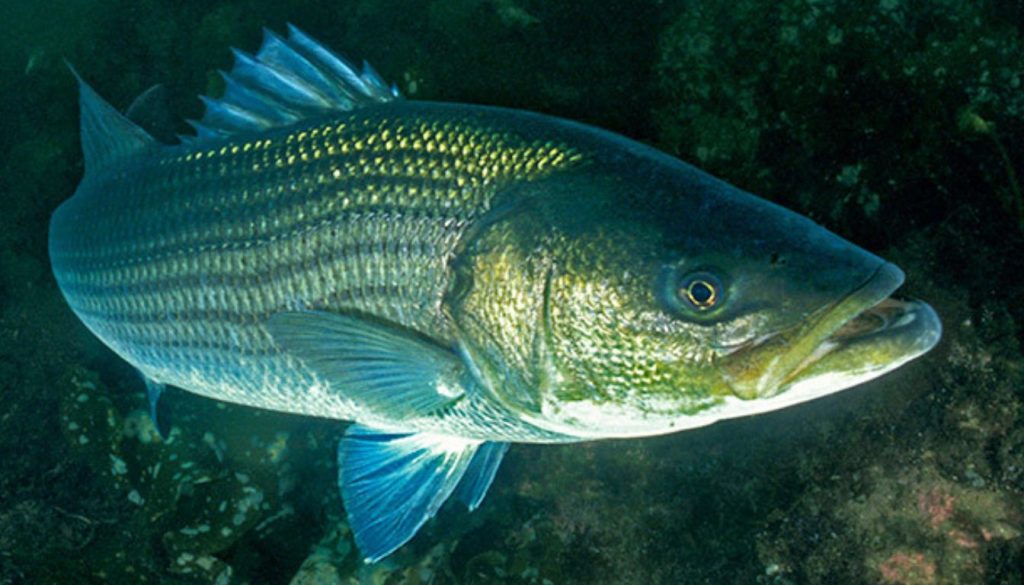
Depths: Depth preference varies with season. Early spring: shallower bays and tidal rivers (10–30 ft or less) warm up first, drawing stripers in. In mid-summer, fish often move deeper to find cooler water (e.g. 40–60+ ft depths near thermoclines or deeper channels). As fall cooling sets in, stripers return to shallower coastal waters and river mouths to feed on migrating bait.
Hotspots: On the East Coast, classic hotspots include Chesapeake Bay and its tributaries, Cape Cod/Monomoy waters, Hudson and Delaware Rivers, Long Island Sound inshore, and the New England surf. West Coast anglers target San Francisco Bay and lakes like Powell or Havasu where stripers were introduced. In general, fish “structure-rich” coastlines and waters known for strong currents (inlets, tidal rivers, dams, channel edges) for the highest strike rates.
Fishing Calendar
🐟 Striped Bass Seasonal Calendar
Timing: Varies by latitude – April to June peak runs depending on location
Post-Spawn: Early summer shift back to coastal feeding areas as temperatures rise
Spring Warming: 48-55°F triggers spawning runs
Summer Heat (>70°F): Target nighttime or deeper water – increased stress/mortality in shallows
Fall Cooling: 40-60°F rejuvenates appetite on shallow flats and inlet bars
Fall: Cooling water + schooling bait = nearshore feeding frenzy
Winter: Southward migration to warmer waters
Spring: Return north as waters warm + spawning runs begin
Prime Windows: The exact timing depends on local temperature and bait availability. Monitor water temps, track bait schools, and watch fishing reports. Spring spawn runs (May-Jun) and fall migrations (Aug-Oct) offer the most consistent action in Mid-Atlantic/Northeast waters. Adjust your strategy based on regional patterns and current conditions for maximum success.
Optimal Conditions
Tides and currents: Stripers often hit hardest on moving tides. Many anglers consider the last hour of an incoming or outgoing tide (and the turn) “prime time.” The in-and-out flow funnels baitfish, and stripers station on the edges of current rips or holes. For surf fishing, an incoming tide (bringing bait closer to shore) is usually best. Slack tide is generally slow, while the swing toward the next tide often ignites feeding. In estuaries, focus on the water flowing over structure (points, cuts) during flood or ebb transitions.
Time of day: Low light greatly increases catch rates. Dawn and dusk are consistently productive for stripers, as in fading or soft light the bass venture near the surface or shallows. Night fishing is also excellent, especially over summer, since stripers often hunt by sound (chasing startled baitfish) and feel more secure under darkness. Bright midday sun usually drives stripers deeper or into shady structure, making them less accessible.
Weather: Overcast skies and light rain are often beneficial. Cloud cover dims light and can trigger midday feeding, while gentle rain can disorient baitfish and stimulate strikes. Moderate winds can help by creating surface chop and carrying scent, but very rough seas or thunderstorms suppress bite. Generally, cool, stable weather and tides that move a lot of water are ideal. (Red water color due to storms or algae can sometimes load with bait – keep an open mind when water is less clear.)
Gear and Techniques
Recommended Setup
Primary Gear: Use a robust medium-heavy setup tailored to striper size and conditions. A typical combo might be a 7′–8′ medium-heavy fast-action rod paired with a 2500–6000-class spinning reel. Spool with braided or fused line (30–50 lb) for main line, plus a heavy fluorocarbon leader (30–50 lb) for abrasion resistance. This strength handles large stripers and rough structure while allowing you to feel subtle strikes. Use high-quality drag: it should be set well below line-breaking tension to let big bass take runs without breakage. Braking drag first runs (30–40% of line test) is a good baseline.
Alternative Setup: For very big fish or surf work, up-size everything. A heavier rod (8′–10′ medium-heavy or heavy) and an 8000-size reel with 50–80 lb braid plus 50–80 lb leader will let you throw heavy sinkers (4–8 oz) and control trophy bass in strong currents. Conversely, for lighter-school stripers or freshwater fishing, a 6′6″–7′ medium or medium-light rod with 10–20 lb braid/20–30 lb leader can be used. Tailor your line choice: for tangled structure, heavier braid is safer; in clear or shallow spots, stepping down to 20–30 lb braid (with a minimum 20 lb leader) avoids spooking fish.
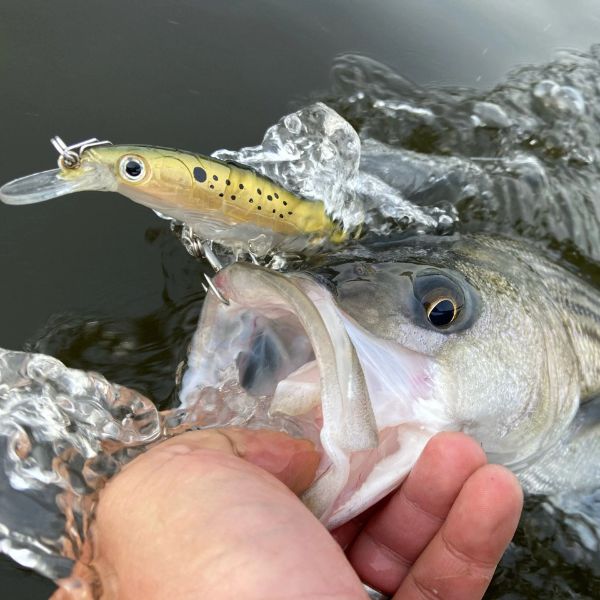
Effective Baits and Lures
Top 3 Natural Baits:
- Menhaden (Bunker): Fresh menhaden (also called bunker or alewife) are often unbeatable, especially in spring/summer. Rig live bunker whole or with only the tail cut off on a sliding-sinker rig. A simple approach is to cast a live fish on a circle hook under a bobber or free-line with a small weight, allowing it to swim in bait schools. Cut bunker also works: remove the tail and chunk or filet the body into strips. Use a fish-finder (sliding sinker) rig with 2–4 oz to keep the cut bait near the bottom or mid-depth.
- Eels: Blood eels or smaller eels are a fantastic striper bait in many areas. Rig a live eel on a double-hook or large circle hook, usually with a sliding egg sinker (1–3 oz) ahead. Drift or slow-troll it under a slip float, or simply free-line it in current. Because few species other than stripers take eel, it’s excellent for isolating big fish. Keep eels cool and in wet cloths to stay lively.
- Clams/Worms: Soft baits like bloodworms, sandworms or clams (shucked) are deadly in structure-rich, tidal waters. Stripers can’t crush whole shells, so anglers shuck hard clams and thread or pile the meat on the hook. Use a mid-weight fish-finder rig (2–4 oz) or simply anchor and toss chunk after chunk of clam/bloodworm near drop-offs or holes. The scent plume from clam and worm makes stripers home in even in murky water. (Sand eels and squid strips can substitute where worms/clams aren’t available.)
Essential Lures: Modern lures offer versatility and the ability to cover water. Top choices for stripers include:
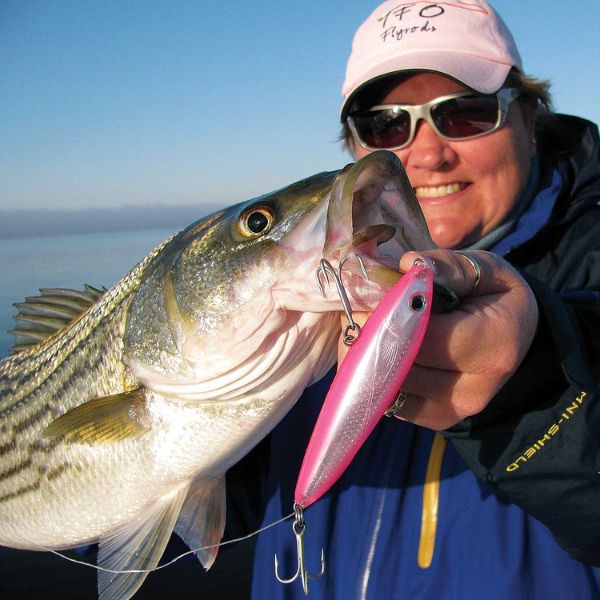
Bucktail/Parachute Jigs: A 1/2–3 oz bucktail jig (or similar parachute jig) in white or chartreuse is a workhorse. Fish these with a yo-yo retrieve over submerged structure or with slow bottom bounces to trigger aggressive strikes. Chartreuse heads and white skirts mimic common bait and catch attention in low light. Add a silicone chunk or plastic trailer on a bucktail to imitate a fleeing baitfish.
Shad-Body Jerkbaits & Swimbaits: Suspended jerkbaits or paddletail swimbaits (4–6″) that imitate herring or shad are very effective. Lures like the MirrOlure or Rapala X-Rap in pearl/white or chrome colors often score kills. Cast past a school or under diving birds and retrieve with twitches, pauses, or a steady twitch-swim cadence. In bright or shallow conditions, white and silver reflect natural bait. In stained water or night, darker colors (black/chartreuse) can silhouette well.
Topwater Plugs: For dawn/dusk and surf fishing, a walking-topwater (e.g. Zara Spook) or popping plug can be deadly. Retrieve with “walk-the-dog” action, pausing on breaks to draw explosive surface strikes. Bright colors (chartreuse/white) are often best at sunrise/sunset, while black may work well on dark nights.
- Rigging notes: Tie on lures with loop knots to allow free action. Use strong split rings and consider trimming barb tips for easier hooksets and release.
Fishing Techniques
Casting & Retrieving (Lure Fishing): Identify likely holding areas (bait schools, structure) and cast ahead of fish orInto current: For jigs and swimbaits, let the lure sink to the desired depth, then retrieve with jerks or pulses so the lure swims enticingly. Vary the speed — a pause often triggers follows to strike. If bass are deep, use a weight or heavy jig to reach them. Over open flats or along drop-offs, combine mid-depth trolling with casts to cover water. When fish are surface-feeding, switch to topwater plugs with a fast walk or pop.
Drift Fishing (Bait Fishing): In a boat, drifting with live or chunk bait is a go-to tactic. Anchor or drift down-current of a reef or ledge, then cast live eel, menhaden or squid strips out into the flow. Use enough weight (2–6 oz) to keep bait in the strike zone. Keep tension on the line; at the first tap, lift the rod firmly. Drifting intact or cut bunker by a slip float is especially effective when schools roam. When drifting with heavy spoons or jigs, allow them to hit bottom before snapping up in short hops.
Trolling: To cover large areas (offshore or on wide lakes), troll umbrella rigs or multiple lures spread out at various depths. Skinny water rafts with live mullet or artificial eels can be trolled just off the bottom or at mid-depth. This mimics bait schools and often produces strikes from moving bass. Use a spread of plugs, bucktails or diving spoons. (Example: a 5-rod spread with downriggers or planer boards, each trailing a diving plug or jig, works well for moving schools.)
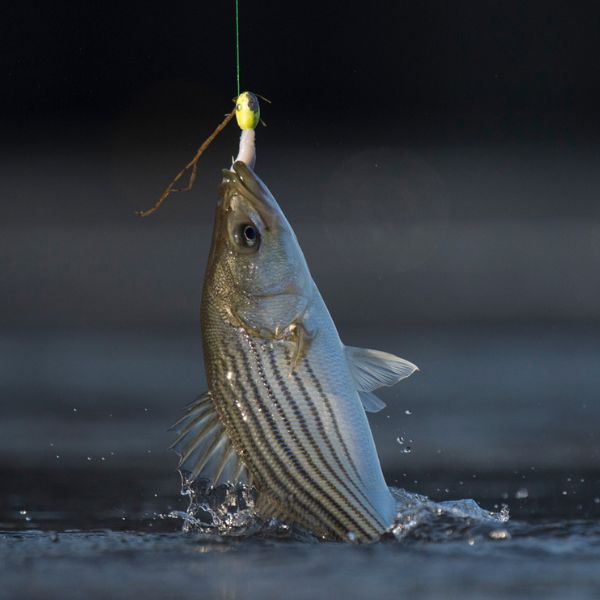
Surf and Shore Fishing: On beaches and jetties, surfcasters use sliding/sinker rigs (fish-finder rig) with large baits. A common setup is a 36–48″ leader with a sturdy circle hook, attached via a swivel to a 6–8 oz sinker on the main line. Cast beyond the breaking waves or into troughs, then wait or slowly retrieve. Night fishing by the surf often requires dragging the rig very slowly to keep the bait in tight seams.
Fish-Finder Rigs: A classic rig for chunk-bait in either boat or surf is the fish-finder (Carolina) rig. It consists of a sliding weight, swivel, and a 3–4′ leader to a circle hook. This keeps bait near the bottom while allowing fish to run. The Virginia DWR emphasizes using circle hooks (often required by law) to improve hook sets and survival on release.
- Pro Tips: Always match the hatch – if you see bluefish or weakfish tearing bait, match sizes/colors of lures or bait accordingly. Use electronics and visual clues (birds, bait pods) to locate fish. When fishing structure, drop a bait right into feeding lanes (e.g. cast up-current of a shoal so the bait drifts through). Night fishing calls for glow or black-light finishes (some plugs have them) and noise – “chugging” topwaters can imitate struggling bait. When fighting a hooked bass, don’t yank; keep the rod tip up (around 10 o’clock) to maintain pressure while reeling downwind on long runs. Avoid fighting fish to exhaustion; it’s better for survival and flesh quality to land them briskly with adequate drag.
Catch and Handling
During the Fight
Striped bass are powerful and prone to long runs. Keep pressure but trust your drag. Set drag so it yields before line breaks, then play the fish. Follow the fish’s direction – don’t let it run under your boat or toward snags or grass. Keep the rod high and let the fish run with some line when needed, then reel in between runs.
- Common mistakes: yanking too hard (which can pull hooks or snap line), or letting the rod tip drop too far down (risking break-offs). With proper gear (heavy enough for the fish), the goal is to tire the bass rather than overpowering it. Remember that stripers often jump, so stay alert to keep the line tight over the gunnel.
Catch and Release
Practice gentle handling to maximize survival. As the Virginia DWR notes, use heavy enough tackle to minimize fight time. Bring fish in quickly and use a large rubber landing net if possible to avoid dry surfaces.
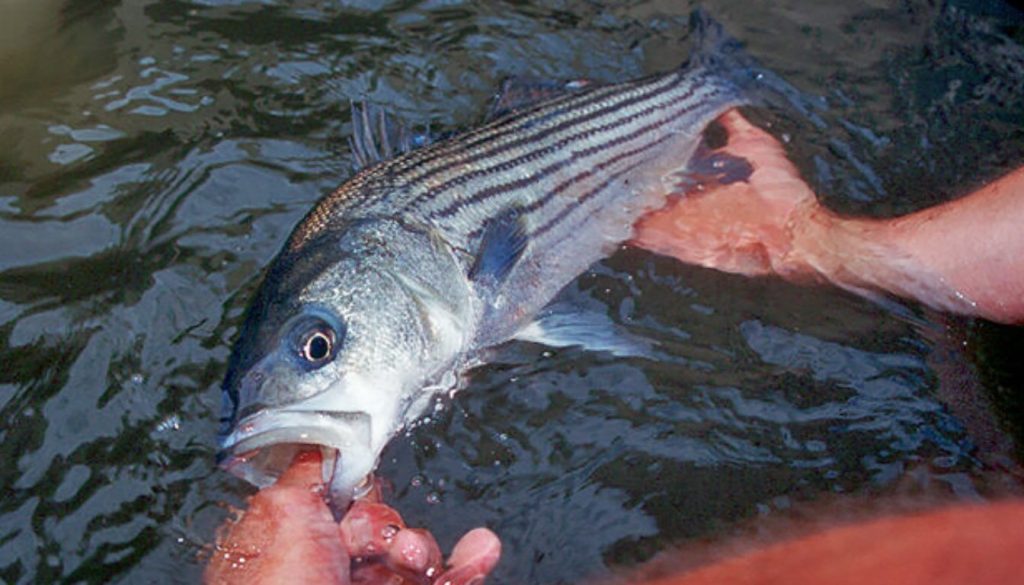
Keep fish wet: Wet your hands before touching the bass to protect its slime coat. Remove hooks swiftly with long-nose pliers or a de-hooker. Support the fish horizontally – one hand under the belly and one at the tail or jaw – rather than hanging it vertically. Avoid touching gills or eyes.
Cut the leader close if the hook is deep; leaving a hook is usually better than prolonged unhooking stress. Minimize air exposure – take photos quickly or better, in the water. Release the bass facing into the current (if boating) or by gently moving it back and forth in place until it swims off on its own.
The DWR reports about 90% survival if these guidelines are followed, so they’re essential for sustainable fishing.
For Consumption
If keeping bass for eating (and within regulations), dispatch humanely and promptly. A swift iki-jime (brain spike) or firm blow to the back of the head will kill the fish instantly with minimal stress.
Bleed the fish immediately by cutting the gill arches or throat; this quick bleed-out improves flavor and shelf life. Then ice the fish on saltwater ice or an ice slurry, keeping the carcass cool as soon as possible.
Gut the fish soon after landing to reduce bacterial growth. Properly handled striper meat will be firm and mild – overfighting or delaying icing can make it “tough” or degrade taste, so the emphasis should be on a quick fight and immediate chilling.
Sources: Information compiled from fisheries biology and angling guides
dwr.virginia.gov and contemporary striper fishing resources
